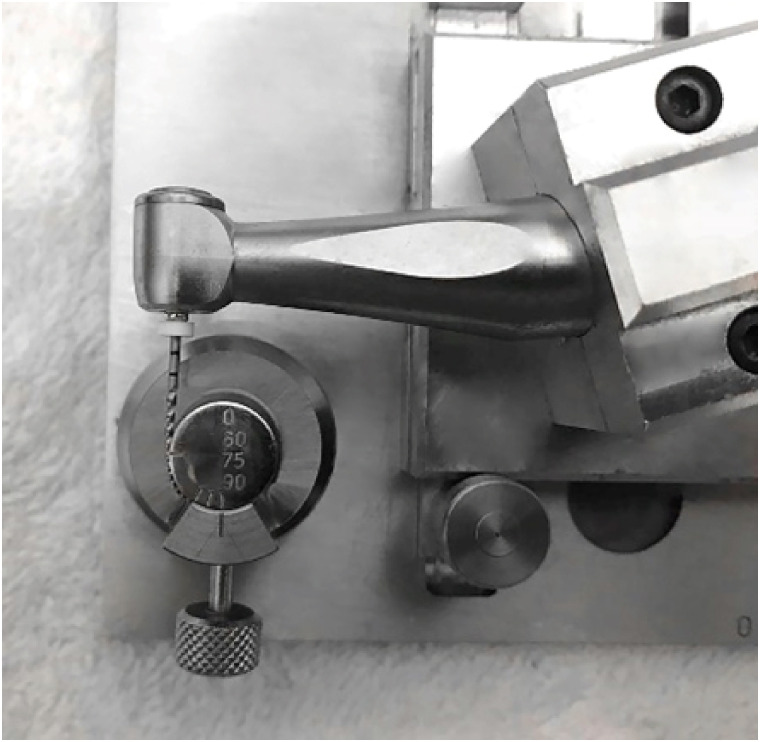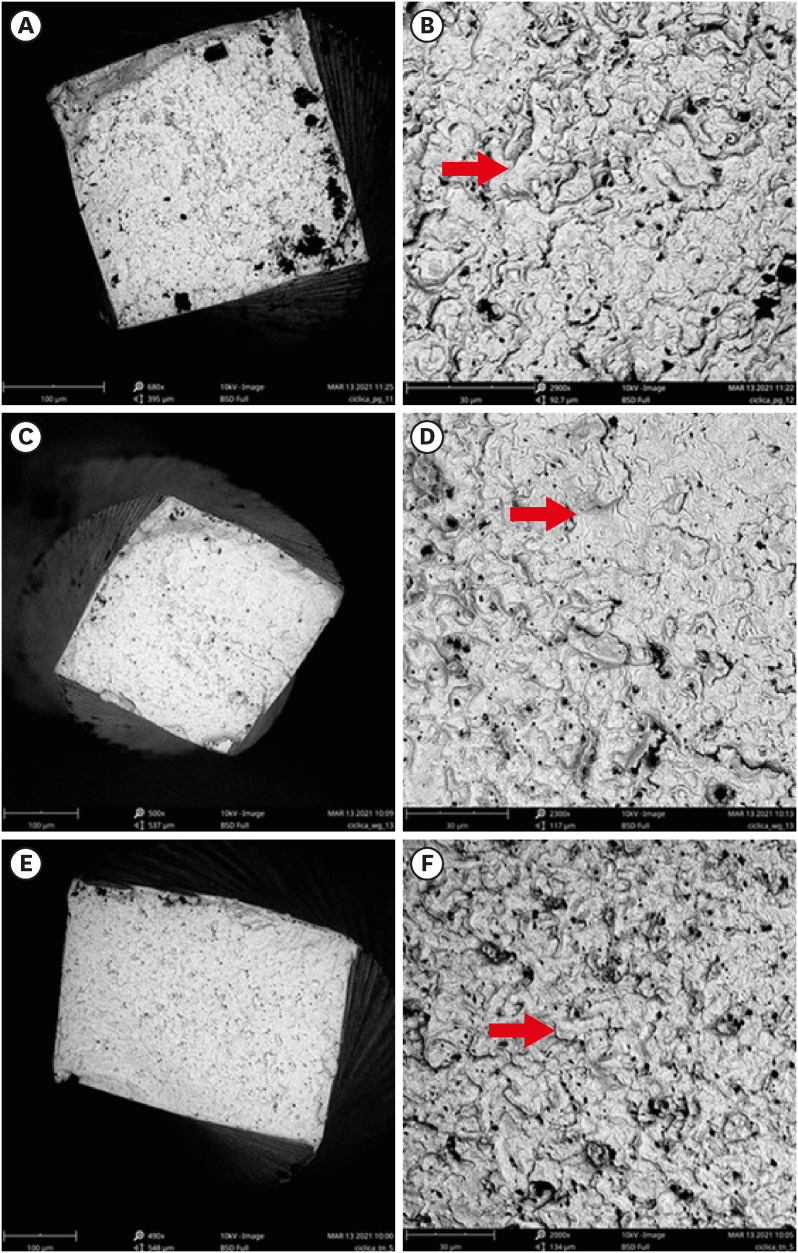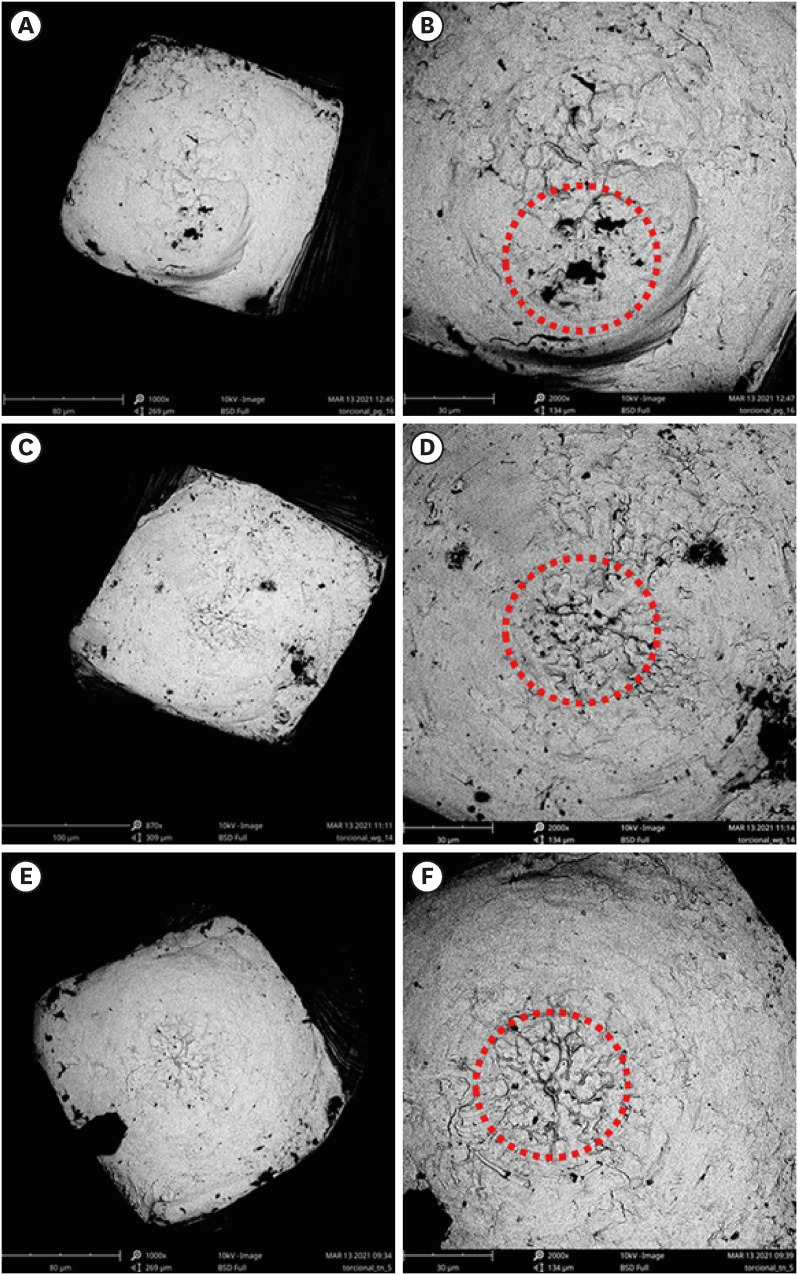Restor Dent Endod.
2023 Feb;48(1):e4. 10.5395/rde.2023.48.e4.
Comparative analysis of torsional and cyclic fatigue resistance of ProGlider, WaveOne Gold Glider, and TruNatomy Glider in simulated curved canal
- Affiliations
-
- 1Department of Endodontics, Faculdade São Leopoldo Mandic, Campinas, SP, Brazil
- 2Department of Endodontics, Universidade de São Paulo (USP), Bauru, SP, Brazil
- KMID: 2548172
- DOI: http://doi.org/10.5395/rde.2023.48.e4
Abstract
Objectives
This study aimed to compare the torsional and cyclic fatigue resistance of ProGlider (PG), WaveOne Gold Glider (WGG), and TruNatomy Glider (TNG).
Materials and Methods
A total of 15 instruments of each glide path system (n = 15) were used for each test. A custom-made device simulating an angle of 90° and a radius of 5 millimeters was used to assess cyclic fatigue resistance, with calculation of number of cycles to failure. Torsional fatigue resistance was assessed by maximum torque and angle of rotation. Fractured instruments were examined by scanning electron microscopy (SEM). Data were analyzed with Shapiro-Wilk and Kruskal-Wallis tests, and the significance level was set at 5%.
Results
The WGG group showed greater cyclic fatigue resistance than the PG and TNG groups (p < 0.05). In the torsional fatigue test, the TNG group showed a higher angle of rotation, followed by the PG and WGG groups (p < 0.05). The TNG group was superior to the PG group in torsional resistance (p < 0.05). SEM analysis revealed ductile morphology, typical of the 2 fracture modes: cyclic fatigue and torsional fatigue.
Conclusions
Reciprocating WGG instruments showed greater cyclic fatigue resistance, while TNG instruments were better in torsional fatigue resistance. The significance of these findings lies in the identification of the instruments’ clinical applicability to guide the choice of the most appropriate instrument and enable the clinician to provide a more predictable glide path preparation.
Figure
Reference
-
1. Topçuoğlu HS, Topçuoğlu G, Kafdağ Ö, Arslan H. Cyclic fatigue resistance of new reciprocating glide path files in 45- and 60-degree curved canals. Int Endod J. 2018; 51:1053–1058. PMID: 29480951.
Article2. Yılmaz K, Uslu G, Gündoğar M, Özyürek T, Grande NM, Plotino G. Cyclic fatigue resistances of several nickel-titanium glide path rotary and reciprocating instruments at body temperature. Int Endod J. 2018; 51:924–930. PMID: 29385639.
Article3. Elnaghy AM, Elsaka SE. Evaluation of the mechanical behaviour of PathFile and ProGlider pathfinding nickel-titanium rotary instruments. Int Endod J. 2015; 48:894–901. PMID: 25266920.
Article4. Uslu G, Özyürek T, İnan U. Comparison of cyclic datigue resistance of ProGlider and One G Glide path files. J Endod. 2016; 42:1555–1558. PMID: 27567035.
Article5. Keskin C, İnan U, Demiral M, Keleş A. Cyclic fatigue resistance of R-Pilot, WaveOne Gold Glider, and ProGlider glide path instruments. Clin Oral Investig. 2018; 22:3007–3012.
Article6. Serefoglu B, Kaval ME, Micoogullari Kurt S, Çalişkan MK. Cyclic fatigue resistance of novel glide path instruments with different alloy properties and kinematics. J Endod. 2018; 44:1422–1424. PMID: 30049469.
Article7. Kırıcı D, Kuştarcı A. Cyclic fatigue resistance of the WaveOne Gold Glider, ProGlider, and the One G glide path instruments in double-curvature canals. Restor Dent Endod. 2019; 44:e36. PMID: 31799164.
Article8. Peters OA, Arias A, Choi A. mechanical properties of a novel nickel-titanium root canal instrument: stationary and dynamic tests. J Endod. 2020; 46:994–1001. PMID: 32389382.
Article9. Alcalde MP, Duarte MA, Bramante CM, de Vasconselos BC, Tanomaru-Filho M, Guerreiro-Tanomaru JM, Pinto JC, Só MV, Vivan RR. Cyclic fatigue and torsional strength of three different thermally treated reciprocating nickel-titanium instruments. Clin Oral Investig. 2018; 22:1865–1871.
Article10. Santos CB, Simões-Carvalho M, Perez R, Vieira VT, Antunes HS, Cavalcante DF, De-Deus G, Silva EJ. Torsional fatigue resistance of R-Pilot and WaveOne Gold Glider NiTi glide path reciprocating systems. Int Endod J. 2019; 52:874–879. PMID: 30586160.
Article11. da Frota MF, Espir CG, Berbert FL, Marques AA, Sponchiado-Junior EC, Tanomaru-Filho M, Garcia LF, Bonetti-Filho I. Comparison of cyclic fatigue and torsional resistance in reciprocating single-file systems and continuous rotary instrumentation systems. J Oral Sci. 2014; 56:269–275. PMID: 25500924.
Article12. Alcalde MP, Tanomaru-Filho M, Bramante CM, Duarte MA, Guerreiro-Tanomaru JM, Camilo-Pinto J, Só MV, Vivan RR. Cyclic and torsional fatigue resistance of reciprocating single files manufactured by different nickel-titanium alloys. J Endod. 2017; 43:1186–1191. PMID: 28527852.
Article13. Pruett JP, Clement DJ, Carnes DL Jr. Cyclic fatigue testing of nickel-titanium endodontic instruments. J Endod. 1997; 23:77–85. PMID: 9220735.
Article14. Lopes HP, Elias CN, Siqueira JF Jr, Soares RG, Souza LC, Oliveira JC, Lopes WS, Mangelli M. Mechanical behavior of pathfinding endodontic instruments. J Endod. 2012; 38:1417–1421. PMID: 22980191.
Article15. Lee JY, Kwak SW, Ha JH, Abu-Tahun IH, Kim HC. Mechanical properties of various Glide Path preparation nickel-titanium rotary instruments. J Endod. 2019; 45:199–204. PMID: 30711178.
Article16. Elnaghy AM, Elsaka SE, Mandorah AO. In vitro comparison of cyclic fatigue resistance of TruNatomy in single and double curvature canals compared with different nickel-titanium rotary instruments. BMC Oral Health. 2020; 20:38. PMID: 32019522.
Article17. Ajuz NC, Armada L, Gonçalves LS, Debelian G, Siqueira JF Jr. Glide path preparation in S-shaped canals with rotary pathfinding nickel-titanium instruments. J Endod. 2013; 39:534–537. PMID: 23522552.
Article18. Arias A, Singh R, Peters OA. Differences in torsional performance of single- and multiple-instrument rotary systems for glide path preparation. Odontology. 2016; 104:192–198. PMID: 25701538.
Article19. De-Deus G, Belladonna FG, Souza EM, Alves VO, Silva EJ, Rodrigues E, Versiani MA, Bueno CE. Scouting ability of 4 pathfinding instruments in moderately curved molar canals. J Endod. 2016; 42:1540–1544. PMID: 27663618.
Article20. Yılmaz K, Uslu G, Özyürek T. In vitro comparison of the cyclic fatigue resistance of HyFlex EDM, One G, and ProGlider nickel titanium glide path instruments in single and double curvature canals. Restor Dent Endod. 2017; 42:282–289. PMID: 29142876.
Article21. Yared G. Canal preparation using only one Ni-Ti rotary instrument: preliminary observations. Int Endod J. 2008; 41:339–344. PMID: 18081803.
Article22. De-Deus G, Moreira EJ, Lopes HP, Elias CN. Extended cyclic fatigue life of F2 ProTaper instruments used in reciprocating movement. Int Endod J. 2010; 43:1063–1068. PMID: 21080616.
Article23. Zupanc J, Vahdat-Pajouh N, Schäfer E. New thermomechanically treated NiTi alloys - a review. Int Endod J. 2018; 51:1088–1103. PMID: 29574784.
Article24. Weissheimer T, Heck L, Calefi PH, Alcalde MP, da Rosa RA, Vivan RR, Duarte MA, Só MV. Evaluation of the mechanical properties of different nickel-titanium retreatment instruments. Aust Endod J. 2021; 47:265–272. PMID: 33296137.
Article25. Pedullà E, Leanza G, La Rosa GR, Gueli AM, Pasquale S, Plotino G, Rapisarda E. Cutting efficiency of conventional and heat-treated nickel-titanium rotary or reciprocating glide path instruments. Int Endod J. 2020; 53:376–384. PMID: 31562824.
Article26. Pereira RP, Alcalde MP, Duarte MA, Vivan RR, Bueno CE, Duque JA, Calefi PH, Bramante CM. A laboratory study of the scouting ability of two reciprocating glide path instruments in mesial root canals of extracted mandibular molars. Int Endod J. 2021; 54:1166–1174. PMID: 33556198.
Article27. Lopes WS, Vieira VT, Silva EJ, Silva MC, Alves FR, Lopes HP, Pires FR. Bending, buckling and torsional resistance of rotary and reciprocating glide path instruments. Int Endod J. 2020; 53:1689–1695. PMID: 32767775.
Article
- Full Text Links
- Actions
-
Cited
- CITED
-
- Close
- Share
- Similar articles
-
- Cyclic fatigue resistance of the WaveOne Gold Glider, ProGlider, and the One G glide path instruments in double-curvature canals
- Effect of glide path preparation with PathFile and ProGlider on the cyclic fatigue resistance of WaveOne nickel-titanium files
- In vitro comparison of the cyclic fatigue resistance of HyFlex EDM, One G, and ProGlider nickel titanium glide path instruments in single and double curvature canals
- Cyclic fatigue life of Tango-Endo, WaveOne GOLD, and Reciproc NiTi instruments
- Comparison of the shaping ability of novel thermally treated reciprocating instruments




